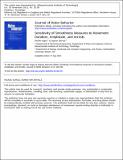| dc.contributor.author | Hogan, Neville | |
| dc.contributor.author | Sternad, Dagmar | |
| dc.date.accessioned | 2011-11-30T19:43:06Z | |
| dc.date.available | 2011-11-30T19:43:06Z | |
| dc.date.issued | 2010-08 | |
| dc.date.submitted | 2009-04 | |
| dc.identifier.issn | 0022-2895 | |
| dc.identifier.issn | 1940-1027 | |
| dc.identifier.uri | http://hdl.handle.net/1721.1/67327 | |
| dc.description.abstract | Studies of sensory-motor performance, including those concerned with changes because of age, disease, or therapeutic intervention, often use measures based on jerk, the time derivative of acceleration, to quantify smoothness and coordination. However, results have been mixed: some researchers report sensitive discrimination of subtle differences, whereas others fail to find significant differences even when they are obviously present. One reason for this is that different measures have been used with different scaling factors. These measures are sensitive to movement amplitude or duration to different degrees. The authors show that jerk-based measures with dimensions vary counterintuitively with movement smoothness, whereas a dimensionless jerk-based measure properly quantifies common deviations from smooth, coordinated movement. | en_US |
| dc.description.sponsorship | Toyota Motor Corporation. Partner Robot Division | en_US |
| dc.description.sponsorship | New York State Spinal Cord Injury Center of Research Excellence (contract CO19772) | en_US |
| dc.description.sponsorship | Massachusetts Institute of Technology. Eric P. and Evelyn E. Newman Laboratory for Biomechanics and Human Rehabilitation | en_US |
| dc.description.sponsorship | National Science Foundation (U.S.) (BCS-0450218) | en_US |
| dc.description.sponsorship | National Institutes of Health (U.S.) (grant R01 HD045639) | en_US |
| dc.description.sponsorship | United States. Office of Naval Research (N00014–05-1–0844) | en_US |
| dc.language.iso | en_US | |
| dc.publisher | Routledge | en_US |
| dc.relation.isversionof | http://dx.doi.org/10.3200/35-09-004-RC | en_US |
| dc.rights | Article is made available in accordance with the publisher's policy and may be subject to US copyright law. Please refer to the publisher's site for terms of use. | en_US |
| dc.source | Taylor & Francis | en_US |
| dc.title | Sensitivity of smoothness measures to movement duration, Amplitude, and Arrests. | en_US |
| dc.type | Article | en_US |
| dc.identifier.citation | Hogan, Neville, and Dagmar Sternad. “Sensitivity of Smoothness Measures to Movement Duration, Amplitude, and Arrests.” Journal of Motor Behavior 41 (2009): 529-534. Web. 30 Nov. 2011. © 2009 Heldref Publications | en_US |
| dc.contributor.department | Massachusetts Institute of Technology. Department of Brain and Cognitive Sciences | en_US |
| dc.contributor.department | Massachusetts Institute of Technology. Department of Mechanical Engineering | en_US |
| dc.contributor.approver | Hogan, Neville | |
| dc.contributor.mitauthor | Hogan, Neville | |
| dc.relation.journal | Journal of Motor Behavior | en_US |
| dc.eprint.version | Final published version | en_US |
| dc.type.uri | http://purl.org/eprint/type/JournalArticle | en_US |
| eprint.status | http://purl.org/eprint/status/PeerReviewed | en_US |
| dspace.orderedauthors | Hogan, Neville; Sternad, Dagmar | en |
| dc.identifier.orcid | https://orcid.org/0000-0001-5366-2145 | |
| mit.license | MIT_AMENDMENT | en_US |
| mit.metadata.status | Complete | |
